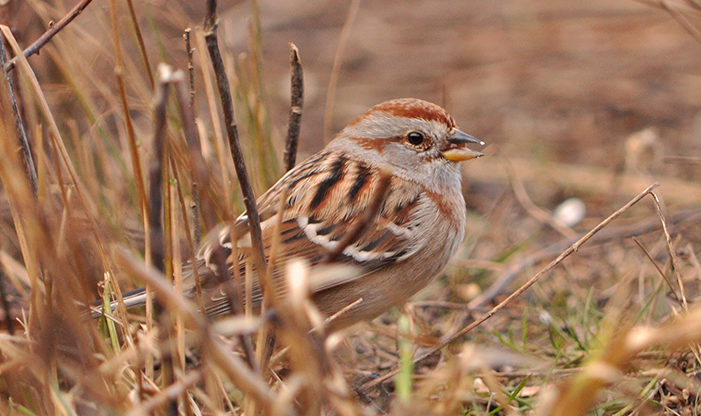While walking the winter trails, calm and stillness permeate the landscape in contrast to the flurry of animal activity observed in other seasons. This quiet time offers a unique opportunity for birding. As you begin your morning walk, scan the treetops in the ravines for unusual dark shapes. Wild Turkeys roost in trees overnight in small groups. Witness their morning routine of taking a short flight to the forest floor to begin foraging.
Winter Birds of the Central Wetlands Loop
The meandering trails of the Central Wetlands Loop pass through woodlands, wetlands, and prairies alive with birds. The transitional area between habitat types, called an ecotone, attracts a variety of bird species. Watch for flocks that gather during winter like Eastern Bluebirds, American Robins, and Cedar Waxwings. Some winter birds only make an appearance at the Center when food becomes scarce further north. Be on the lookout for less frequent visitors like Common Redpolls and White-winged Crossbills.
Seeing Birds from the Lake Terrace Trail
Enjoy a walk on the Lake Terrace Trail to view a variety of ducks on Lake Michigan. At first glance, the ducks look like small black dots floating in the water. A pair of binoculars or a spotting scope will reveal the details necessary to identify the species. Greater Scaup, Common Goldeneye, Bufflehead, and Red-breasted Merganser may form rafts of hundreds of individuals floating in the waves. These “diving ducks” feed in deeper water offshore and disappear under the surface as they search for food.
Watch the sky above the lake for Bald Eagles soaring overhead. Bald Eagle populations are increasing across the state, so sightings are more common than they used to be. Lake Michigan provides eagles with plenty of fish to eat during winter. The woodlands along the Lake Terrace are a great habitat to look for other raptors like Red-tailed Hawks, Cooper’s Hawks, Great Horned Owls, and Eastern Screech Owls. Though not considered raptors, Northern Shrikes are predatory birds about the same size as robins. These songbirds have a habit of leaving small rodents and birds impaled on thorns to save as food later.
Watching Our Bird Feeders
Some of the best winter birding can be found inside the Great Hall, watching our bird feeders. After your hike, grab a cup of coffee or cocoa, a bench near the window, and witness bird behavior up close. Black-capped Chickadees dart in to pick up a seed, then carry it away to eat at a different perch. They will even stash seeds in hiding places to save for later. American Goldfinches and Pine Siskins perch for long stretches of time on the thistle feeder, devouring seeds. Northern Cardinals provide a splash of bright red color as they enjoy some black oil sunflower seeds. Lookalike species, Downy and Hairy Woodpeckers, go straight for the suet feeder. Can you tell them apart by the Hairy’s larger size and longer bill? Look under the feeder for ground foragers like the American Tree Sparrow, Song Sparrow, and Dark-eyed Junco. If you can’t make it to the Center, you can view the birds at our feeder from your home through our feeder cam!


